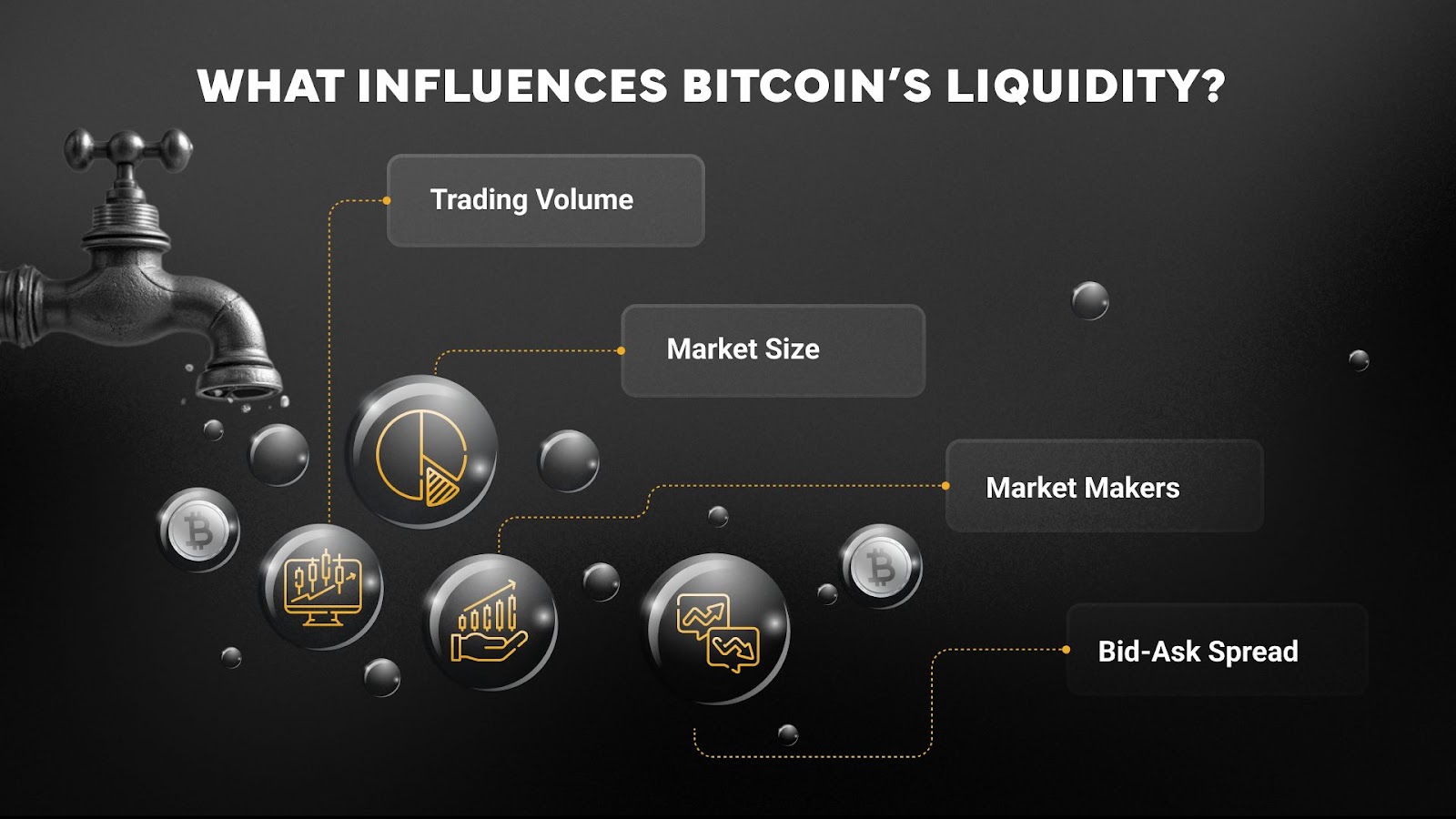Bitcoin
Bitcoin CPI
Venture Portfolio
Funds
Market Insights
Indicators
About
Contact

April 4, 2025





Bitcoin liquidity is an important aspect of the digital currency’s overall health and popularity.
Determined by an array of different factors and metrics, it’s a great way to understand the Bitcoin market, why its liquidity is attractive to investors, and what liquidity-related data can tell you about the market.
In this guide, you’ll learn more about Bitcoin liquidity, what affects it, and what it means for traders and investors.
Bitcoin liquidity refers to the ease and speed with which BTC can be bought or sold without moving its price significantly.
Highly liquid assets can be traded easily since there are many bids and asks of various sizes. Conversely, illiquid assets usually can’t be transacted as easily for the price the seller/buyer is asking, and therefore, these transactions can affect the price significantly.
In the case of Bitcoin, its total liquidity is relatively high but lower than the largest traditional asset classes, such as blue-chip equities and U.S. Treasuries.
BTC’s liquidity also varies across time and platforms. Different factors can drive this up or down, depending on the current situation in the market or a specific platform.

While many factors can affect Bitcoin’s liquidity, let’s examine the ones that play the biggest role in determining how liquid BTC is over a specific period of time.
Trading volume is arguably one of the biggest factors of any asset’s liquidity. In this case, it refers to the amount of Bitcoin being traded on a given exchange or across the market as a whole over a time period, usually 24 hours.
A higher trading volume means more BTC is changing hands, which signals higher liquidity. This also boosts trader confidence and encourages more participation, further increasing liquidity. On the flip side, a lower trading volume suggests lower liquidity and reduced willingness to trade, which can discourage participation and push liquidity even lower.
The bid-ask spread refers to the difference between the highest buying price (the bid) and the lowest selling price (the ask). A narrow spread is one of the attributes of a liquid asset, meaning two sides of a trade are happy with the offered price and vice versa.
Since liquidity refers to the speed and ease with which a trade is executed, a wider spread is indicative of lower liquidity.
Market depth measures how many buy and sell orders at various price levels currently are in order books of trading platforms. The deeper the market is, the more liquid it is, reducing the risk of bigger price swings when large buy or sell orders are being executed.
Market depth helps traders understand how much buying or selling pressure is needed to move the price of BTC significantly. In either case, this measure also varies depending on a trading platform.
Bitcoin is now more than a trillion-dollar market cap asset class that dominates the crypto asset market. Moreover, BTC’s capitalization is well above 50% of the total market cap of all crypto assets. In recent years, Bitcoin has even managed to increase its dominance despite the number of other crypto assets having grown substantially.
Bitcoin's market cap even surpassed that of silver in November 2024, while it’s also relatively close to the market caps of giants such as Alphabet and Amazon, which have a longer history than BTC.
Market makers play an essential role in Bitcoin liquidity by continuously quoting buy and sell prices, helping to stabilize prices and facilitate trades. On CEXs, they profit from the bid-ask spread and manage risk with real-time position adjustments. On DEXs, they also provide liquidity—often earning token incentives for supporting new launches.
A larger number of active market makers tends to correspond with more liquidity and vice versa.
Bitcoin is the most liquid crypto asset in the market, easily outpacing all the others with market depth, transaction volume, and number of traders, among other measures.
Having said that, BTC is less liquid than some of the top Forex trading pairs, U.S. Treasuries, and blue-chip stocks.
For example, daily trading volume in Forex reaches trillions of USD, while BTC has only surpassed 100 billion USD during its most active trading periods. The bid-ask spread and market depth are typically better in traditional assets than in the Bitcoin market.
However, Bitcoin, as a relatively nascent asset class, is also catching up, thanks to the growing adoption among big institutional investors. More retail investors are also entering the market, helping its liquidity, which, in turn, makes it more attractive for more investors of all kinds.
It’s important to note that liquidity is always changing and is different across trading platforms. Therefore, traders are also looking at different factors in both BTC and traditional markets trying to predict changes in liquidity, which can also affect the price of the most popular cryptocurrency.
Bitcoin's liquidity is a crucial factor for traders to assess both the advantages and potential risks of establishing positions with this asset. While Bitcoin maintains the highest liquidity in the cryptocurrency space, it still falls short compared to certain traditional assets, though this gap continues to narrow.
Generally speaking, Bitcoin's growing popularity attracts more traders to the market, which increases trading volume and market depth while improving the bid-ask spread. This positive cycle enhances overall liquidity and creates a smoother trading experience, making the asset increasingly attractive to both retail and institutional investors.
Disclaimer: The content of this blog post is not investment advice and does not constitute any offer or solicitation to offer or recommendation of any investment product.
Bitcoin’s liquidity can be checked using metrics such as trading volume, bid-ask spread, and market depth. Some of these can be found on data aggregators such as CoinMarketCap, Coinglass, and others. It’s important to note that all these metrics should be analyzed together to give you a holistic picture of the current liquidity in the BTC market.
The ease with which Bitcoin can be liquidated depends on several factors: the liquidity on the chosen exchange or trading platform, the bid-ask spread, and the market depth. It’s still easier to liquidate Bitcoin compared to other crypto assets, but it can be harder than liquidating some blue-chip stocks, for example.